“I Felt Keenly All the Horrors of War”: Psychological Experiences of Civil War Generals During the Mexican War
There is no shortage of connections between the Mexican War (1846-48) and the American Civil War. When Lee and Grant met at Appomattox in April 1865, the two adversaries eased the tension by evoking memories of the Mexican War. Lee and Grant were just two of the 336 of 1,008 Civil War generals (33%) who served in the War with Mexico (not including Union brevet brigadier generals), many of which held senior positions in both the Confederate and Union armies. This led Dr. Otis A. Singletary to call the Mexican War “a roll call of Civil War commanders.”[1]
For dozens of future generals, many serving as junior officers, the Mexican War was a war of firsts: their first exposure to enemy fire; the first time they commanded men in action; and the first time that they witnessed death on the battlefield and the loss of a comrade. While studies have focused on the lessons Civil War generals like Grant, Lee, Jackson, and McClellan learned on Mexican War battlefields—later implemented during the Civil War—and the friendships forged during the war, a thorough analysis of their emotional responses to death is lacking. Most witnessed death for the first time, and felt shock, horror, and grief, expressing these sentiments in their journals, letters, and memoirs.[2]
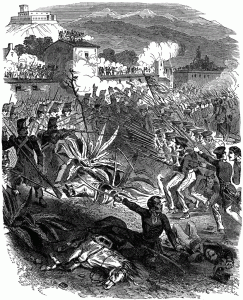
“Oh, how shall I describe the horror of my feelings,” wrote 21-year-old Benjamin Franklin Scribner in 1847, a regiment and brigade commander during the Civil War, but at the time serving as an infantryman in the Second Indian Volunteers. He provided a brief account of his reaction to the death of Apollos Stephens, a member of the “Spencer Greys,” killed at the bloody Battle of Buena Vista in February 1847. “There lay quivering in death one of my comrades, with his eyes upturned, and the tears starting from them,” a disturbed Scribner recalled. “It was and touching scene—one that will never be effaced from my memory.”[3]
The trauma Scribner experienced was shared by others during the war. “[A]fter the excitement of battle had passed away our sympathies were aroused,” 25-year-old Lieutenant John James Peck of the Fourth U.S. Artillery, a future Union major general who commanded the works at Suffolk in 1863, wrote after weathering his first two battles. “I felt keenly all the horrors of war.”[4]
Lieutenants Ulysses S. Grant and Alexander Hays, at the time serving as junior officers in the Fourth Infantry, underwent similar traumatic experiences during the first two battles of the war, Palo Alto (May 8) and Resaca de la Palma (May 9).
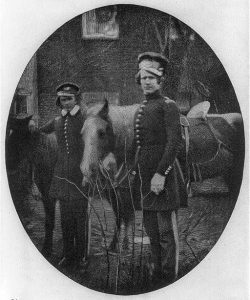
Toward the tail end of the fighting at Palo Alto, the Fourth Infantry came under heavy fire from the Mexican artillery, attempting to stave off their advance. Three days after the battle, 24-year-old Grant wrote to his fiancée, Julia Dent, and told her how he felt no fear as “the balls were whizzing [sic] thick and fast about me.” He did admit that he had a near-death experience when “a ball struck close by me killing one man instantly,” continuing that “it nocked [sic] Capt. [John] Page’s under Jaw entirely off and broke the roof on his mouth, and nocked Lt. [Henry Davies] Wallen and one Sergeant down besides me…”
A corporal of the regiment was nearby when he caught a glimpse of Page’s mangled face. “[H]e was knocked down in the grass, and as he endeavored to raise himself, he presented such as ghastly spectacle that a sickly, fainting sensation came over me,” the nauseated soldier recalled, “and the memory of that sight I shall carry with me to my dying day.”[5]
Forty-four-year-old Captain George Archibald McCall, a friend of Page, and later a brigadier general during General McClellan’s 1862 Peninsula Campaign, watched in horror as his friend’s face was disfigured by a six-pound cannon-ball. “As I passed him,” McCall wrote to a relative after the battle, “poor fellow, he presented a shocking sight.” [6]
Perhaps to conceal his true sentiments—a trait he had inherited from his mother—Grant chose to repress his feelings to Julia when his fellow officers were killed. But this incident undoubtedly left an impression on him. Over a month after the battle, Grant wrote to his friend John William Lowe, of Batavia, Ohio, expressing pity for Page. “During the days fight I scarcely thought of the probability or possibility of being touched myself,” Grant told Lowe. That was at least “until, near the close of the evening a shot struck the ranks a little way in front of me and knocked one man’s head off, knock [sic] the underjaw of Capt. Page entirely away, and brought several others to the ground.” The young lieutenant provided a ghastly description of the captain’s injury to Lowe. “The underjaw is gone to the wind pipe, and the tongue hangs down upon the throat,” Grant noted. “He never will be able to speak or eat.”[7]
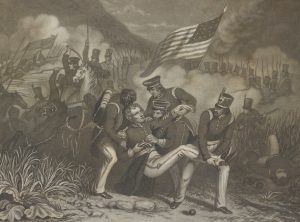
Nearly four decades later, as was dying from throat cancer and writing his memoirs, Grant recalled his first experience under fire. “One cannon-ball passed through our ranks, not far from me,” he wrote as if he was reliving the battle as he penned these sentences. “It took off the head of an enlisted man, and the under jaw of Captain Page of my regiment, while the splinters from the musket of the killed soldier, and his brains and bones, knocked down two or three others, including one officer, Lieutenant Wallen,—hurting them more or less.” Grant kindly spared his readers, like he had Julia, from the graphic details of Page’s wound. But he had not forgotten this haunting scene; he vividly recalled it all these years later. It was indelibly etched into his mind.[8]
On the same field that Grant watched Page lose his jaw, 26-year-old Alexander Hays and 27-year-old Richard E. Cochrane, fellow Pennsylvanians, fought side by side for the first time. The two lieutenants had become fast friends over the preceding weeks. “[N]o one, knew his hopes fears, feelings, or thought more intimately than myself,” Hays would later write of Cochrane. Both survived the bombardment that eventually ended Page’s life.
As nighttime approached after five hours of fighting, Brigadier General Zachary Taylor ordered his soldiers to sleep on the ground captured from the Mexicans. Before nodding off, Hays and Cochrane expressed their longing for their sweethearts “and the pleasing hopes of a happy meeting.” Hays had recently married the daughter of a Pittsburgh jeweler, Annie A. McFadden, before he headed to Mexico, while Cochrane had a wife, Sally, and a little girl, eagerly waiting for his safe return.[9]

On May 9, the day after Palo Alto, Taylor’s army followed on the heels of General Mariano Arista’s badly mauled Mexican army. Cochrane and Hays once again entered the fray as the Fourth Infantry attempted to root out the Mexican soldiers and cannon entrenched in the dense chaparral and along a resaca.
During the fierce hand-to-hand struggle, thirty men, including Hays and Cochrane, broke through the Mexican line and advanced several hundred yards ahead of the main body. Enemy lancers spotted the isolated infantrymen and charged them. Hays scurried back to seek shelter from the horsemen in the dense chaparral. From his elevated position, he watched Cochrane, who became separated from the party, bolt toward the abandoned enemy camp.
After two well-directed volleys by the reformed Americans, the lancers retreated. Some passed through the camp where Cochrane was hiding. When it was clear, Hays entered the camp and discovered his comrade’s body pierced by seven lance wounds. Cochrane still clenched his bloody sword as he attempted to ward off his assailants before being killed.[10]
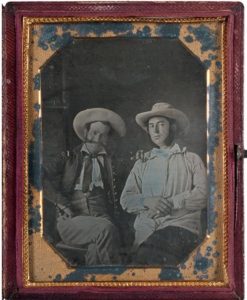
Hays ordered soldiers of Cochrane’s company to retrieve his body and carry it back to the American camp. Before burying his remains, Hays removed Cochrane’s wedding ring and a lock of his hair. He had the soldiers construct a crude wood railing around the grave, hoping to distinguish his remains among the other officers and soldiers buried.
Three months later, Alexander Hays hoped to meet Cochrane’s widow at New Orleans but missed her. Instead, he wrote to Sally and provided her with a meticulous account of the events leading to her husband’s death. Hays described Richard as being the “kindest of friends,” and noted that “We marched side by side…and were scarcely separated.” He ensured Sally that her gallant husband did not express a foreboding that this would be his last battle. “I am confident if he had a thought or wish to express,” Hays declared, “I would have been the recipient of it.”[11]
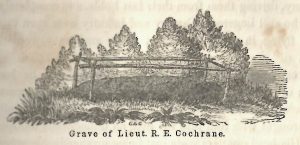
Grant, Hays, and other junior officers experienced the shock of war and the loss of a comrade for the first time at Palo Alto and Resaca de la Palma in May 1846. “Now that the war has commenced with such vengeance [sic],” Grant declared to his fiancée following the May 9th battle, “I am in hopes my Dear Julia that we will soon be able to end it.” Dozens of other men who rose to the rank of general during the American Civil War went through similar experiences during the Mexican War, shaping each in different ways and leaving lasting impressions and emotional scars well before they faced the carnage of the American Civil War thirteen years later.[12]
Endnotes
[1] Kevin Dougherty, Civil War Leadership and Mexican War Experience (Jackson: University Press of Mississippi, 2007), xi; Otis A. Singletary, The Mexican War (Chicago: University of Chicago Press, 1960), 4.
[2] Felice Flanery Lewis, Trailing Clouds of Glory: Zachary Taylor’s Mexican War Campaign and His Emerging Civil War Leaders (Tuscaloosa: The University of Alabama Press, 2010), xvii; Dougherty, Civil War Leadership and Mexican War Experience; Martin Dugard, The Training Ground: Grant, Lee, Sherman, and Davis in the Mexican War, 1846-1848 (New York, Little Brown, 2008).
[3] Benjamin Franklin Scribner, Camp Life of a Volunteer: A Campaign in Mexico, or a Glimpse at Life in Camp by “One Who Has Seen the Elephant” (Philadelphia: Grigg, Elliot & Co., 1847), 60-61.
[4] Richard F. Pourade, ed., The Sign of the Eagle: A View of Mexico, 1830 to 1855. Letters of Lt. John James Peck, U.S. Soldier in the Mexican War (San Diego: Union-Tribute, 1970), 26.
[5] Ron Chernow, ed., My Dearest Julia: The Wartime Letters of Ulysses S. Grant to His Wife (Library of America, 2018), 38; C.M. Reeves, “Five Years An American Soldier, Comprising Adventures at Palo Alto, Resaca de la Palma, Monterrey, Vera Cruz, Cerro Gordo, and in the Battles in the Valley of Mexico, Interspersed with Anecdotes of Military Life, in Peace and War,” in Over the World: Travels, Adventures and Achievements, ed. Henry Howe (Philadelphia: Bradley, Garretson & Co., 1883), 142-43.
[6] George A. McCall, Letters from the Frontiers (Philadelphia: J. B. Lippincott & Co., 1868), 453-454.
[7] Lewis, Trailing Clouds of Glory, 66; Ron Chernow, Grant (New York: Penguin Books, 2018), 7; Ulysses S. Grant to John W. Lowe, June 26, 1846, Lowe Collection, Dayton Metro Library in Dayton, Ohio.
[8] Ulysses Simpson Grant, Personal Memoirs of U.S. Grant: Two Volumes in One (New York: Charles L. Webster & Company, 1894), 60-61.
[9] Alexander Hays to Sally Cochrane, August 7, 1846, Richard E. Cochrane Papers, 1838-1859, Dolph Briscoe Center for American History, The University of Texas, Austin, Texas; Alexander Hays to Sally Cochrane, November 8, 1846, Richard E. Cochrane Papers, 1838-1859, Dolph Briscoe Center for American History, The University of Texas, Austin, Texas; George T. Flemming and Gilbert Adams Hays, eds., Life and Letters of Alexander Hays: Brevet Colonel United States Army, Brigadier General and Brevet Major General United States Volunteers (Pittsburgh: G.A. Hays, 1919), 63.
[10] Reeves, “Five Years An American Soldier”, 445-46; Alexander Hays to Sally Cochrane, August 7, 1846; Alexander Hays to Sally Cochrane, November 8, 1846; Flemming and Hays, Life and Letters of Alexander Hays, 46.
[11] Alexander Hays to Sally Cochrane, August 7, 1846; Alexander Hays to Sally Cochrane, November 8, 1846.
[12] Chernow, My Dearest Julia, 38.
Thanks. I regrettably have failed to imagine the impact this had on Civil War officers.
Thanks for the great article! It would be interesting to have a detailed account of Lee and Grant discussing the Mexican War. That would actually interest me more than the surrender discussion. It wouldn’t be about shared experiences, because they had none, unlike Lee and Meade who actually worked together. Grant condemned the war almost as a US atrocity, while Lee was Scott’s ‘go to’ man with his important and dangerous missions, vital to it’s successful outcome.